Strong Apart: Humane + Connected Aging
- Global Health
- Sustainable Development
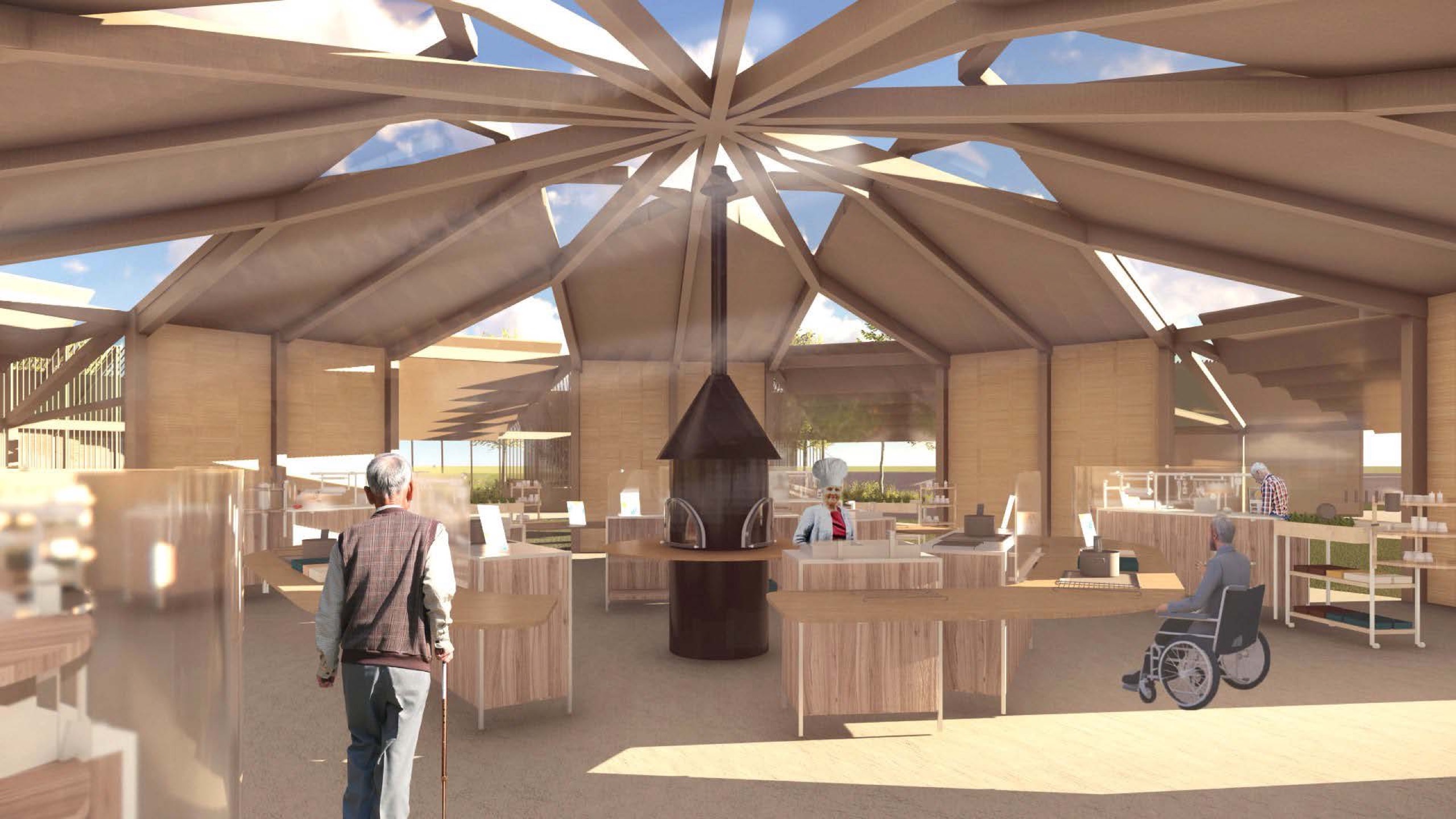
This Designmatters studio challenged transdisciplinary ArtCenter students to design spatial experiences that offer emotional, mental and physical support for older adults facing extreme isolation because of the pandemic. Students learned how the global crisis has illuminated the psychosocial issues and inequities faced by homebound older people, especially those who are ethnic minorities, ill or in nursing homes, palliative or hospice care systems.
Students engaged in workshops interacting with healthcare providers and practitioners, policy makers, designers and activists. Through the process of co-creation and a lens of empathy-based design, students researched and developed solutions that would promote community, well-being and connection.
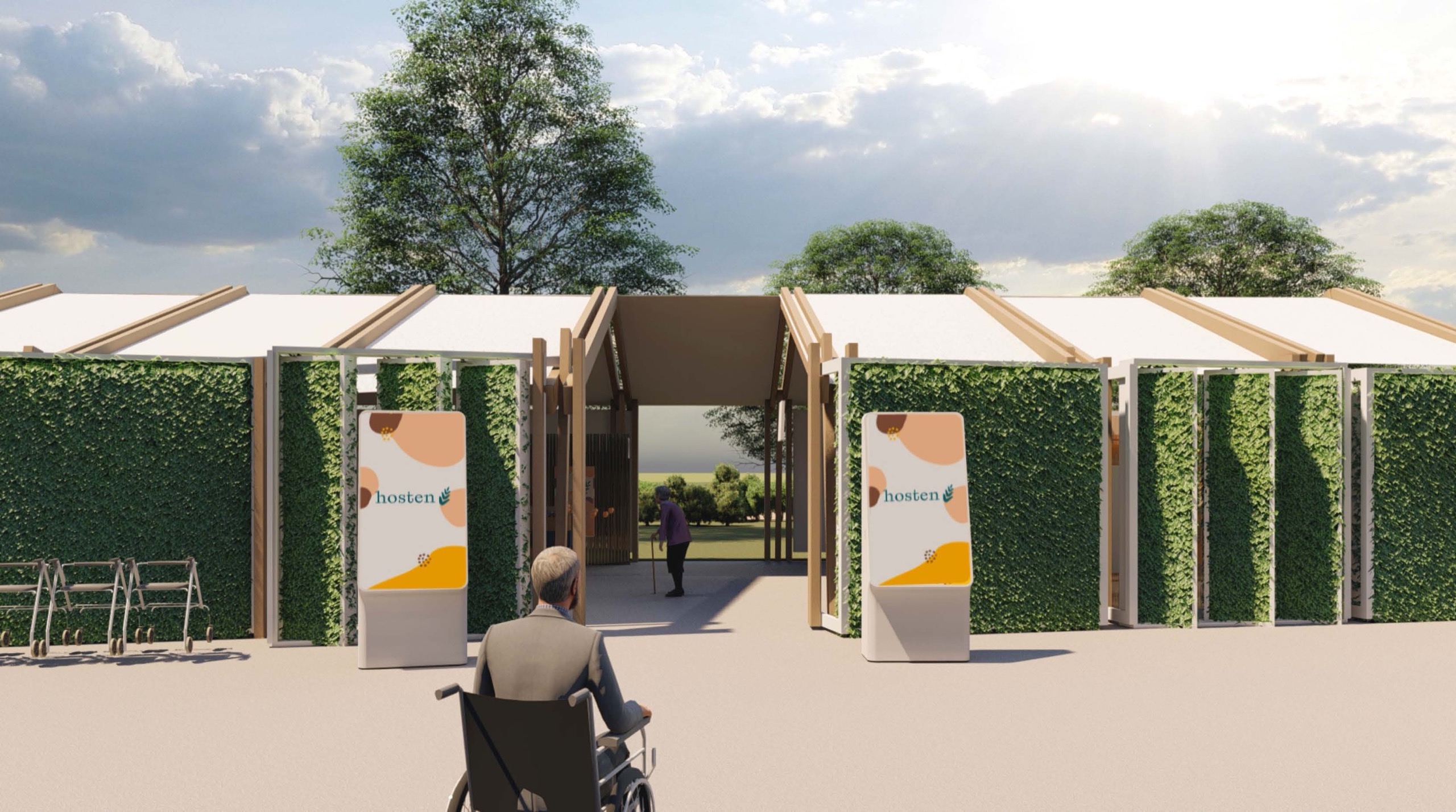
“Thank you for this opportunity to learn how to look at the world in different ways. Aging is the future for all of us. It’s the underserved population we are all going to be a part of one day. So really, you are designing for your own future.”
Dr. Freddi Segal-Gidan, Gerontologist & Associate Professor of Clinical Neurology, USC
Project Brief
Transdisciplinary ArtCenter students focused on how the global crisis has illuminated the psychosocial issues and inequities faced by older people, especially those who are ethnic minorities, ill, or in nursing homes, palliative or hospice care systems. Engaging with healthcare providers and practitioners, policy makers, designers and activists, students conceptualized spatial experiences that would offer emotional, mental and physical support as well as care for older adults.
Through the process of co-creation and a lens of empathy-based design, students researched and developed solutions that would promote community, well-being and connection.

“There’s a lot of thought here and it’s not about ‘fixing’ aging, but creating joy within the spaces. Such as finding joy in daily functions, in food and movement. Thank you for bringing so much joy and normalcy to your projects.”
Liz Lanphear, ArtCenter staff, Center for Diversity, Equality and Inclusion
Research and Project Development
The studio kicked off with students sharing personal stories about their families, and of aging relatives facing a variety of challenges. Instructors reiterated that design, as a service profession, is employed to meet human needs, and that the current society is slowly transitioning attitudes about older adults from a treatment culture to a more caring culture.
Knowledge partners were introduced to the students; these experts in the field would be available to assist students by sharing their networks and resources, as well as experience and insight.
Students heard presentations from three knowledge partners as an introduction. Laura Trejo, General Manager of the City of Los Angeles Department of Aging, reminded students that aging is shaped by many factors, and also that loneliness and solitude can be deadly for seniors. Dr. Scott Kaiser discussed that genetics is not the only factor that determines how we age, but that food, exercise, sleep and access to medicine are other important elements to consider. Rigo Sanorio of St. Barnabas Senior Services talked about the impact of COVID on his clientele and how homelessness, food insecurity and chronic-care issues are shaping the lives of many older adults.
After the formal presentation, students described aspects that resonated with them as they explored their own personal attitudes about aging. Students were challenged to dig deeper into the reality of what being an older adult in America truly means. Many times, older people are considered a “problem” to solve rather than a resource. How can design help change this cultural thinking?
Students were divided into teams, often partnered with those from different disciplines to bring new ideas and fresh approaches to the process and final project.
Inspiration, Ideation and Implementation
The first third of the studio time focused on conducting research and making observations that would lead to specific insights. Many students connected with their parents, grandparents or elderly relatives who provided valuable opinions and experiences; often, these individuals would later help co-create or test prototypes.
As they developed empathy with their audience, teams crafted specific research questions and conducted expert and user interviews. Students researched the different challenges that face older adults, and not just during pandemic times. Issues that have become engrained in today’s culture include transportation limitations and barriers, architectural design that doesn’t consider physical abilities, confusing layouts in grocery stores, living in neighborhoods without easy access to fresh food, the realities of social isolation, a reluctance to use digital media for purchases, and products that are hard to manipulate with older hands.
Above all, students realized that older adults want to stay in their homes as long as possible before moving into institutionalized housing.
During the Research Review, in week four, teams shared specific insights and analysis, and presented their ideas on areas of opportunities, along with initial concept proposals.
Gearing up for a midterm presentation, teams examined their overall objectives by creating storylines and personas, as well as ideating possible solutions. Students considered innovative possibilities that could be affordable and easy to navigate for seniors and their caregivers. Students connected with Knowledge partners for direction, and carefully considered how their solutions would address specific pain points.
Midterm presentations gave students the opportunity to describe their target audience via personas, to present their research and interview findings, and to offer initial ideation solutions. ArtCenter faculty and Knowledge partners provided constructive feedback on the projects, offering suggestions on how teams could continue a forward-moving momentum.
For the remainder of the studio, teams developed their projects with individual members taking on responsibilities for certain aspects. Some teams built prototypes, created video trailers, and designed diagrams and schedules. Students circled back to interview subjects and tested their concepts, with the results helping teams further refine their projects. Storyboarding a user’s experience allowed the teams to visualize how their concepts could be put into action and be beneficial to the target audience.
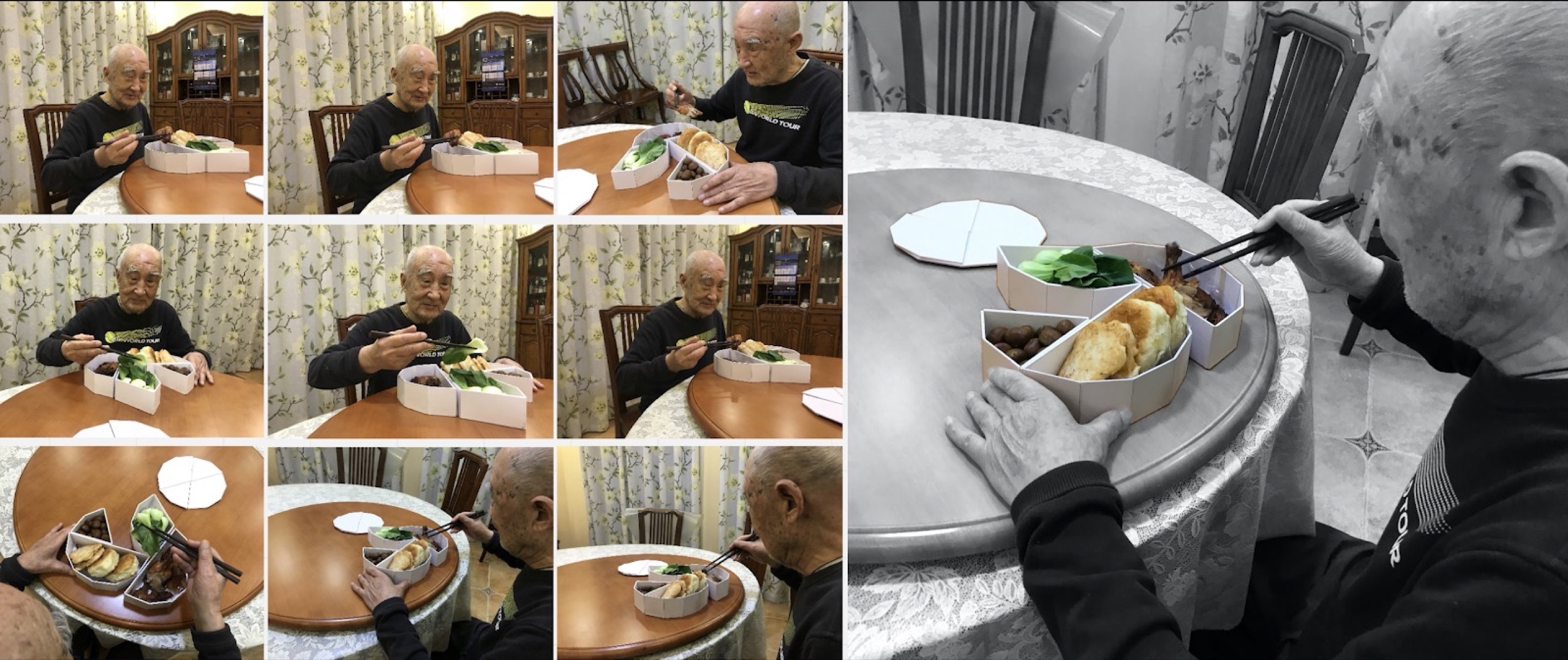
“I think that if social impact design has one goal, it is to inspire others to change their own mindsets and habits for an inclusive future. Learning about aging changed how I speak about older adults, how I think about my own life trajectory, and how as a member of the younger generation I can make an impact right now with my design skills.”
Ibby Day, ArtCenter illustration student
Outcomes
 close
close
Go-Grocer
Read moreIbby Day, Ruoxin Bai, Huangchen Qi
Instacart-meets-food truck is the concept that brings high quality grocery products and farmer’s market produce to densely populated areas with older adults who have limited mobility to access a neighborhood grocery store.
A fleet of delivery trucks will be retrofitted to include an interior shopping space, accessed by a ramp, for refrigerated items. The outside shopping areas will pop-out and expand to display fresh fruit and vegetables along with other high-demand items such as canned goods, rice, bread, etc.
The trucks will set up operations in an outdoor space where shoppers can browse or pick up items pre-ordered on an app. Shoppers can also purchase an assortment of common goods via a food bundle that could reflect cultural tastes. A public seating area around the truck will encourage community members to mingle and meet their neighbors. A touchscreen on the truck will digitally display recipes (with printed versions available) and shoppers can also share their personal recipes with each other here.
Next steps for the project would be to start up partnerships with local grocery stores, farmer’s market vendors and city government officials.
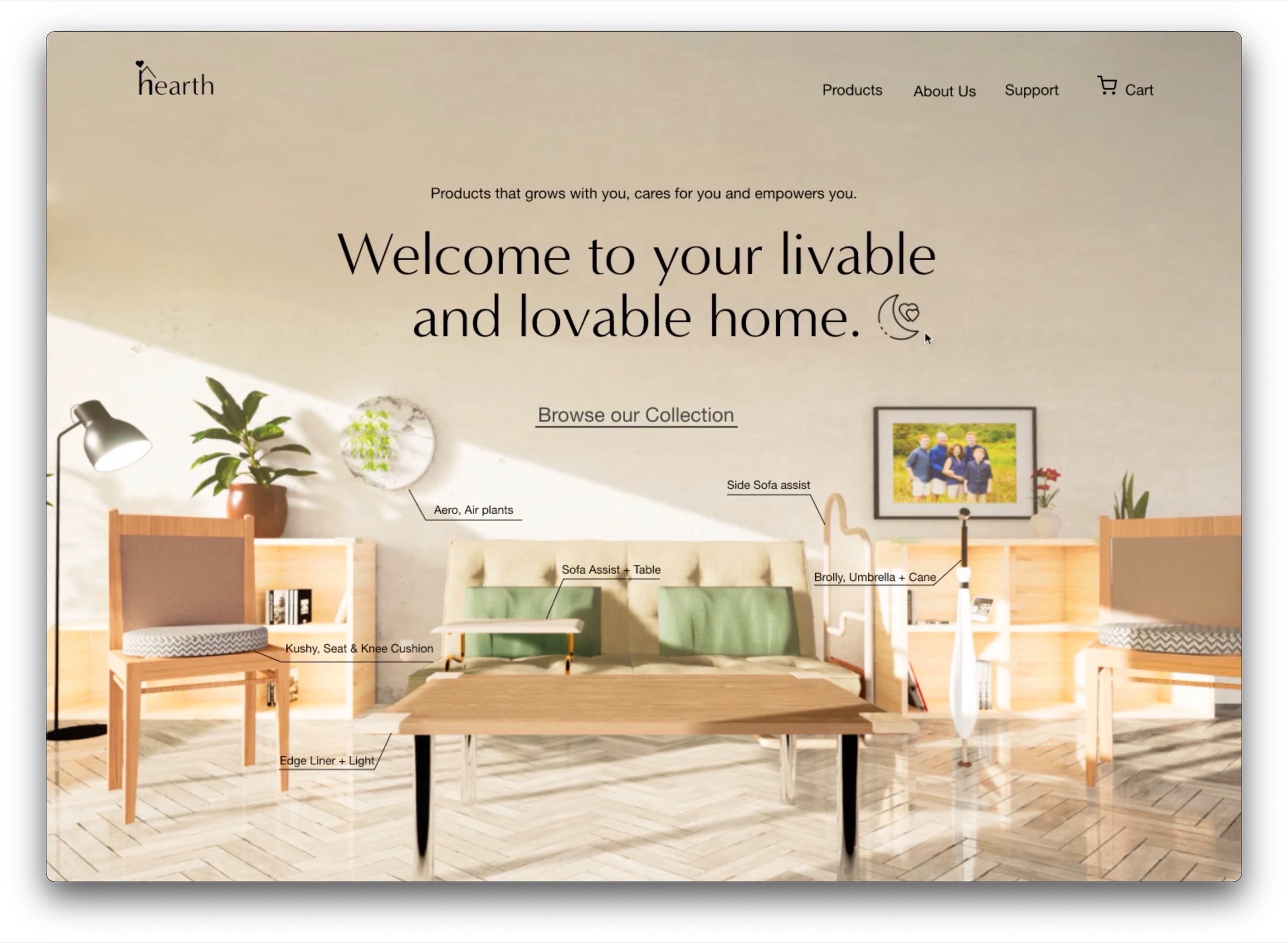 close
close
Hearth
Read moreAziza Tanjung, Lucas Thin, Jason Yin
Older adults want to remain in their homes as they age, but are often restricted from making necessary alterations if they live in rental units. Hearth is a product line of functional and fashionable devices that aren’t major structural modifications, but assist the elderly so they can remain active and safe in their own homes.
To counter the medical and hospital-like design of most home health care products, Hearth items are customizable and aesthetically pleasing. Users access the easy-to-read website to browse items that are grouped by functionality in certain rooms: bathroom, kitchen, etc. Products include an umbrella that is also a walking stick, easier-to-use door handles, railings, a bathing chair, a series of battery-operated or plug-in lights that illuminate walking paths and more.
Some items encourage the user to upload artwork — maybe a grandchild’s drawing — to be used as a design element.
If the website appears overwhelming with choices, users can opt for an essential kit of eight main products. When ordered, products are delivered by a volunteer who will help the user understand how to properly employ the products in their home.
Next steps for the project would be to create additional kits and coordinate efforts with occupational therapists.
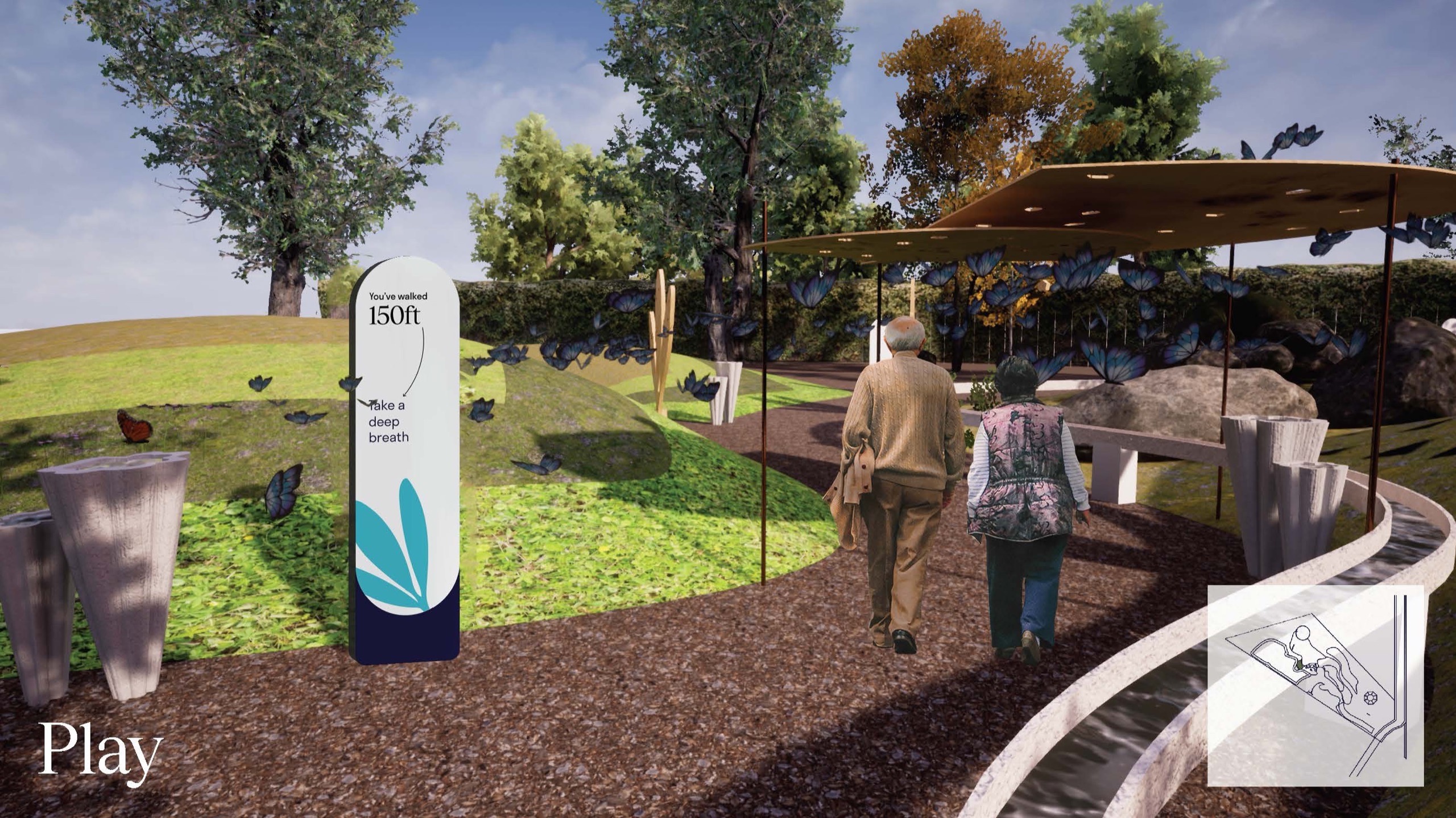 close
close
Dewdrop
Read moreAna-Paola Laveaga, Mei Xia
Coping with grief is difficult under any circumstances, but the pandemic has amplified the loneliness and lack of ritualized farewells for older adults. Dewdrop is a healing garden that welcomes individuals facing isolation to experience the power of nature as they engage in a restorative communal project.
In partnership with One Generation in Reseda, the garden will be located in a currently empty location near the L.A. River and within walking distance of One Generation. Guests who wish to visit the site must make an online reservation with date and time.
Guests check in with volunteers at the site, which is accessed via a bridge. Flat, level cork and rubber surfaces make it easier for older adults to walk through the garden. Handrails are also positioned in targeted areas, as are benches that serve as rest stops. Color-branded signage gives suggestions for observation, such as “listen for birds,” or “watch for butterflies.” Shaded areas are designed along the walking path and carefully placed sculptures reflect a meditative tranquility. The walk is designed to be offer calming, reflective moments for visitors, especially those who have recently experienced a loss.
Before they leave the garden, guests can participate in a restorative gardening project where they can commemorate a loved one. Visitors pot a California native plant which, when big enough, will be transplanted into the environment. Before exiting, guests can add their own comments to a reflection wall that asks: “What do you miss the most?”
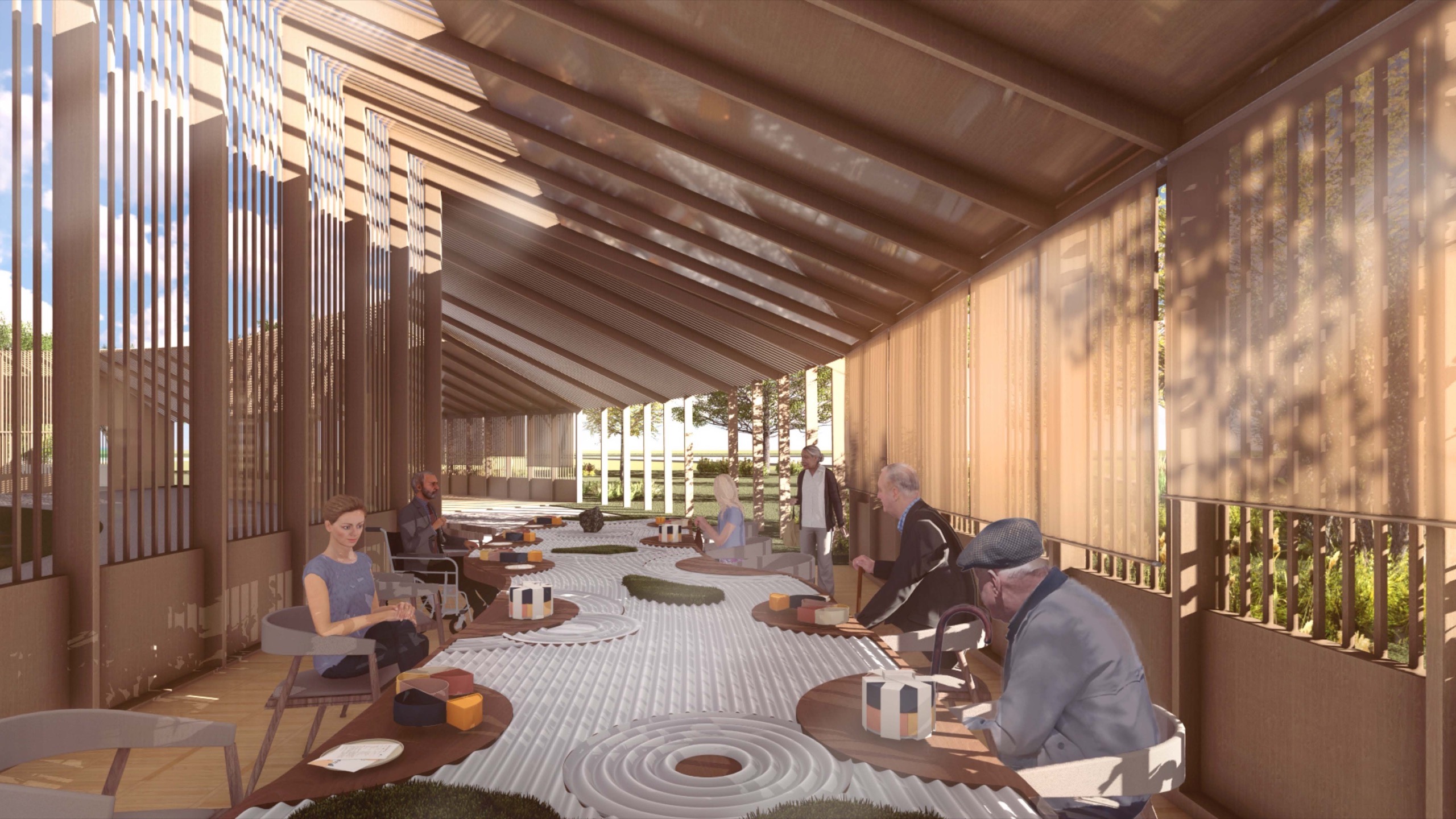 close
close
Hosten
Read moreHelen Huang, Shannon Tsai, George Wend
A warm and friendly communal space, Hosten creates community through an ecosystem of products and services that involves cooking and sharing of food. Hosten will be located near Lake Balboa Park, a convenient location for participants of One Generation, which can advertise the upcoming cooking classes and events.
Hosten will be implemented in two phases: current pandemic time and post-pandemic.
Visitors sign up for a particular event via an app, and staff at One Generation can assist guests with a reservation if necessary. Once on site, guests can enter a shaded pavilion-like structure where farmers have set up a market. The rotational panels help shade during extreme heat; the building is powered with solar panels.
After shopping, guests enter the kitchen area, where a circular set of individual cooking stations face a central stage. There, the chef of the day will demonstrate how to cook a specific dish or entire meal.
After the meal is prepared, guests enjoy their food at a dining space that is wheelchair accessible and where seats are appropriately socially distanced. The curvy table is accentuated on top by a Zen-garden like design of flowing grooves. Guests can have their food prepared to-go in a colorfully designed Bento boxes that are textured for hands to easily grasp and hold. Nearby, guests can take a recipe card (with nutritional facts) from the day’s lesson so they can recreate the meal at home.